Introduction:
The first time I truly understood the meaning of off-grid camping was during a disastrous trip to the Blue Ridge Mountains that almost ended my outdoor adventures forever. Picture this: Me, a complete novice, armed with nothing more than a cheap tent, a half-empty water bottle, a woeful lack of proper off-grid camping gear, and more confidence than common sense. It was July, the humidity was suffocating, and I had exactly zero percent of the skills I thought I possessed.
Imagine being miles from civilization, surrounded by nothing but pristine wilderness, with everything you need to survive and thrive right in your backpack. That’s the dream I was chasing—though my first attempt looked more like a comedy of errors! I learned the hard way that off-grid camping isn’t just about having gear; it’s about understanding how to use that gear when everything goes wrong.
In 2024, technology and innovative gear have transformed how we approach remote camping, making it more accessible and exciting than ever before. Gone are the days when off-grid camping meant suffering through uncomfortable nights and questionable survival skills. Today, it’s a sophisticated blend of technology, preparation, and pure adventure.
Whether you’re a seasoned adventurer or a weekend warrior looking to escape the digital world, this comprehensive guide will equip you with the knowledge and gear to make your off-grid camping experience unforgettable! I’m sharing everything I’ve learned—from my embarrassing mistakes to the game-changing gear that turned me from a wilderness disaster into a confident outdoor enthusiast.
Trust me, if I can go from nearly calling a search-and-rescue team during my first camping trip to now planning multi-day off-grid expeditions, anyone can master the art of wilderness survival. Let’s dive into the ultimate guide that will transform your outdoor adventures!
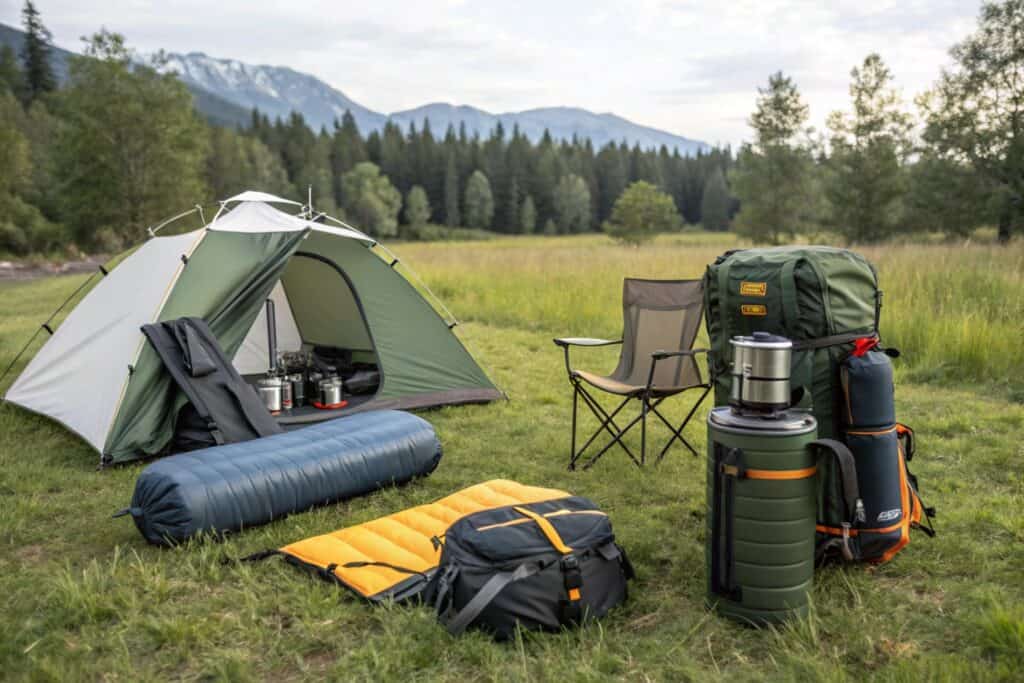
Essential Shelter and Sleeping Gear for Off-Grid Camping
Let me tell you about the night I learned that not all tents are created equal. It was a freezing autumn weekend in the Cascades, and my bargain-bin tent looked more like a wet paper bag after just two hours of mountain rain. I was shivering, soaked, and questioning every life choice that led me to this moment.
Shelter isn’t just a luxury in off-grid camping—it’s your lifeline. I’ve since become obsessed with finding the perfect balance between weight, durability, and protection. Here’s what I’ve learned through countless nights of trial, error, and occasional misery:
Choosing the Right Tent: More Than Just Fabric and Poles
Lightweight doesn’t mean weak, and expensive doesn’t always mean better. My current go-to is a four-season tent that weighs just under 4 pounds but can withstand winds that would make lesser shelters cry. Key features I now refuse to compromise on:
- Ripstop nylon with waterproof rating of at least 1500mm
- Full-coverage rain fly that extends to the ground
- Aluminum pole system for strength without bulk
- Vestibule space for gear storage and mud protection
Pro tip: Always practice setting up your tent before hitting the wilderness. I learned this after spending one particularly humiliating hour wrestling with tent poles in the dark, with mosquitoes treating me like an all-you-can-eat buffet.
Sleeping Systems: Your Comfort Depends on More Than Just a Bag
Sleeping bags are where science meets survival. I discovered the hard way that a 40-degree bag doesn’t mean comfort at 40 degrees—it means survival. For off-grid camping, invest in a system, not just a bag:
- Sleeping bag rated at least 10 degrees lower than expected temperatures
- Insulated sleeping pad with R-value appropriate to your environment
- Compact liner for additional warmth and versatility
- Compression sack to minimize pack space
My worst night ever? A camping trip in the Sierra Nevada where I thought my summer sleeping bag would “be fine.” Spoiler alert: It was not fine. I spent the night doing involuntary jumping jacks inside my sleeping bag just to generate heat.
Emergency Shelter: Your Backup Plan
Sometimes, your primary shelter fails. Always pack a lightweight emergency option:
- Ultralight bivy sack
- Compact emergency tent
- Heavy-duty emergency blanket
- Lightweight tarp with paracord
I carry an emergency bivy that compresses smaller than a soda can. It’s saved my bacon during unexpected storms and those “just in case” moments that remind you nature doesn’t care about your plans.
Insider Tricks I’ve Learned the Hard Way
- Always pack your sleeping bag in a waterproof compression sack
- Use a ground cloth even if your tent has a built-in floor
- Keep critical gear like headlamp and emergency warmth layer easily accessible
- Never store wet gear inside your sleeping bag
The wilderness doesn’t care about your comfort—but with the right preparation, you can trick it into feeling like home. My first truly comfortable off-grid night wasn’t about having the most expensive gear, but about understanding how to use what I had effectively.
Remember, good shelter is the difference between an epic adventure and a miserable survival story. Choose wisely, prepare thoroughly, and always check the weather before you go!
Off-Grid Power Solutions and Charging Systems
Nothing says “modern wilderness adventure” quite like the moment your last battery bar dies in the middle of nowhere. Trust me, I’ve been that guy frantically waving a smartphone toward the sky, hoping for a miracle signal while my emergency communication device gasps its last electronic breath.
My wake-up call came during a remote trek in the Olympic National Forest. I had packed what I thought was a robust power setup—turns out, “robust” is a relative term when you’re miles from the nearest outlet. That trip taught me that off-grid power is part science, part survival art, and completely essential in 2024.
The Evolution of Portable Power
Modern off-grid power isn’t just about throwing a few batteries in your pack anymore. We’re talking smart, adaptive power systems that can keep you connected and safe in the most challenging environments. My current setup is a carefully curated arsenal of charging solutions that would make a tech geek weep with joy:
- Portable solar panels with built-in battery storage
- Multi-output power stations
- Lightweight kinetic and wind-up charging technologies
- Specialized camping battery packs
- Hybrid charging solutions that combine multiple power sources
Pro tip: Never rely on a single power source. Diversification isn’t just for investing—it’s for survival.
Solar Power: More Than Just a Trendy Accessory
I used to think solar chargers were a gimmick. Now? They’re my most trusted wilderness companion. The game-changers I’ve discovered:
- Foldable solar panels that fit in a jacket pocket
- Panels with integrated battery storage
- Waterproof and shock-resistant designs
- Charging efficiency that works even in low-light conditions
My favorite setup is a 20W portable solar panel that can fully charge a power bank in about 4-5 hours of decent sunlight. It’s lightweight, durable, and has saved my communication capabilities more times than I can count.
Power Management Strategies
Conserving power is an art form in off-grid camping. Here are my hard-earned strategies:
- Use airplane mode to extend battery life
- Carry backup battery packs
- Prioritize essential devices
- Use low-power modes whenever possible
- Carry universal adapters that work with multiple device types
The Backup Plan: When Technology Fails
I always pack a set of backup power solutions that don’t rely on electricity:
- Hand-crank emergency radio
- Waterproof, shock-resistant power banks
- Backup alkaline batteries
- Manual charging devices
- Solar-powered emergency beacon
Technology to Watch in 2024
The future of off-grid power is mind-blowing. Emerging technologies I’m excited about:
- Graphene-based super-fast charging batteries
- Flexible, lightweight solar panels
- Kinetic charging clothing
- Advanced hydrogen fuel cell portable chargers
- AI-optimized power management systems
The Most Important Lesson
Power management in the wilderness isn’t about having the most expensive gear. It’s about understanding your devices, planning ahead, and being prepared for anything. My worst nights weren’t about lack of gear—they were about lack of preparation.
Pro survival hack: Always test your power systems before you go. A dry run can save you from a potentially dangerous situation in the wild.
Remember, in off-grid camping, your power solution is more than a convenience—it’s a lifeline. Choose wisely, pack smartly, and never underestimate the importance of staying connected, even when you’re disconnecting from the world.
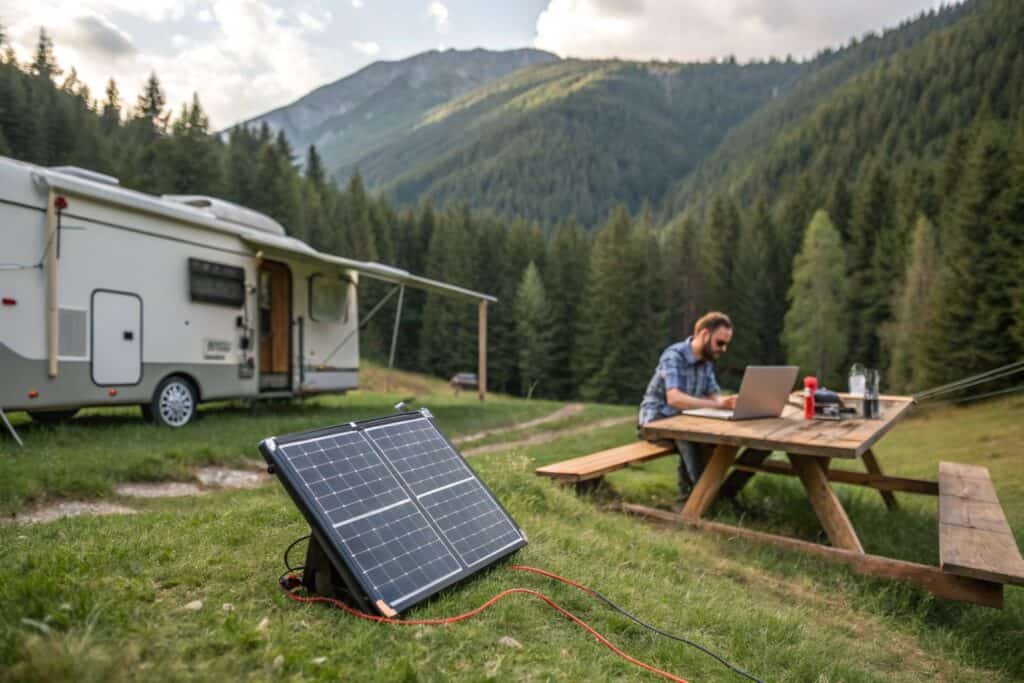
Water Filtration and Purification Strategies
Water nearly killed me once. Not in the dramatic drowning sense, but in the quiet, insidious way that comes from thinking, “This stream looks clean enough.”
It was a backpacking trip through the Alpine wilderness of Montana. I was young, cocky, and completely convinced that my pristine mountain stream water was “natural” and therefore safe. Three days of violent intestinal distress later, I learned the most important lesson of wilderness survival: Never, Trust, Untreated ,Water.
The Science of Water Survival
Water filtration isn’t just a camping trick—it’s a critical survival skill. In 2024, we’ve got technologies that would make astronauts jealous. My current water treatment arsenal looks like something between a science lab and a special forces kit:
- Ultralight water filter systems
- UV water purification devices
- Chemical treatment options
- Gravity-fed filtration solutions
- Multipurpose water containers with integrated filtration
Filtering vs. Purifying: Know the Difference
Most campers don’t realize there’s a critical distinction:
- Filters remove physical particles and bacteria
- Purifiers eliminate viruses and chemical contaminants
- Some advanced systems do both
Top Water Treatment Technologies
My go-to solutions have saved me countless times:
- Portable Pump Filters
- Lightweight (under 8 ounces)
- Removes 99.9999% of bacteria and protozoa
- Filters up to 1,000 liters before replacement
- Works in virtually any water source
- UV Purification Devices
- Kills microorganisms with ultraviolet light
- Charges via USB or solar
- Treats water in 60 seconds
- Works with clear water sources
- Gravity-Fed Systems
- Perfect for base camp scenarios
- Can process multiple liters simultaneously
- Minimal physical effort required
- Ideal for group camping
Survival Hacks I’ve Learned
Hard-earned wisdom from years of wilderness adventures:
- Always carry multiple water treatment methods
- Learn to identify potentially contaminated water sources
- Know how to pre-filter murky water
- Understand local water conditions before your trip
- Practice using your water treatment gear before you go
Emergency Water Collection Techniques
When your primary methods fail, knowledge becomes your lifeline:
- Solar still construction
- Condensation collection methods
- Plant transpiration techniques
- Reading landscape for water indicators
- Understanding watershed geography
The Psychological Aspect of Water Procurement
Here’s something they don’t tell you in survival guides: Finding water is as much mental as physical. Panic is your worst enemy. Stay calm, assess your environment, and remember that humans can survive weeks without food, but only days without water.
2024 Water Treatment Game Changers
Technology is revolutionizing how we approach water in the wilderness:
- Nano-filtration technologies
- Smart water bottles with built-in purification
- AI-assisted water quality assessment
- Predictive hydration tracking devices
- Lightweight, multi-stage purification systems
The Ultimate Survival Mindset
Water isn’t just about hydration—it’s about survival. Every drop you successfully treat is a victory against the wilderness. My most important lesson? Respect the water, prepare meticulously, and never take safe drinking water for granted.
Pro Tip: Your water treatment system is only as good as your ability to use it quickly and efficiently under stress. Practice until it becomes muscle memory.
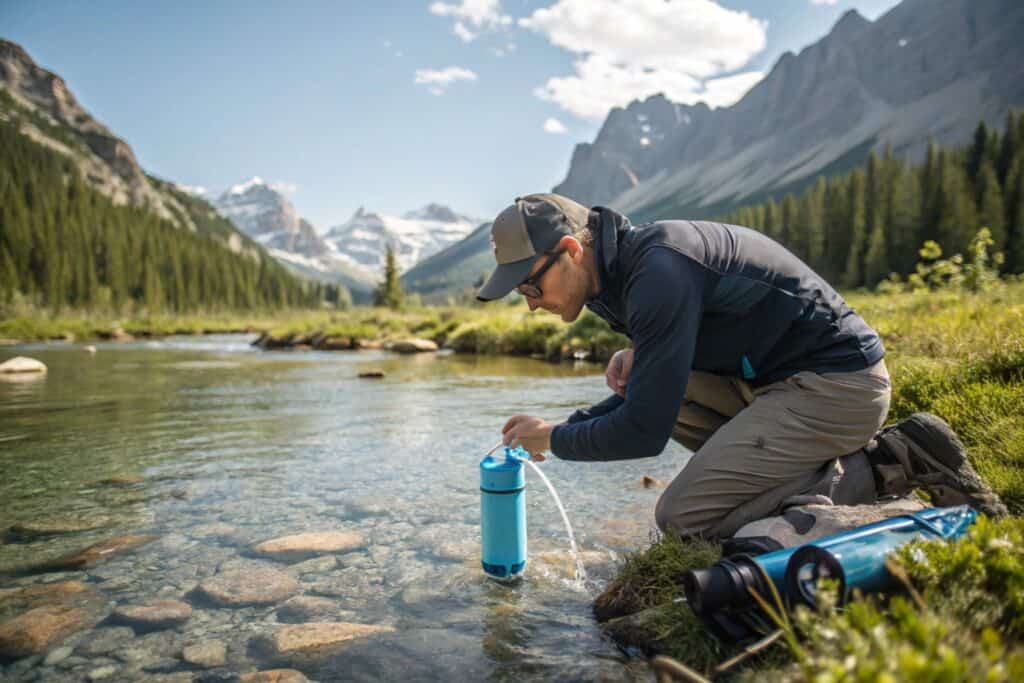
The day I realized navigation was more than just following a trail was the day I got spectacularly lost in the dense forests of the Pacific Northwest. Picture this: me, a supposed “experienced” hiker, spinning in circles, my fancy smartphone as useful as a paperweight, with storm clouds gathering and daylight fading. That’s when I learned that true wilderness survival is an art form—and technology is just one brush in your toolkit.
Gone are the days when a compass and a paper map were your only hope. In 2024, navigation is a sophisticated dance between cutting-edge technology and old-school wilderness skills:
- Advanced GPS devices with multi-satellite support
- Satellite communication systems
- Offline mapping technologies
- Backup analog navigation tools
- Emergency signaling devices
- Primary Navigation Tools
- Rugged GPS devices with extended battery life
- Offline mapping apps with downloadable terrain maps
- Multiple satellite system compatibility (GPS, GLONASS, Galileo)
- Topographical mapping capabilities
- Backup Navigation Systems
- Traditional magnetic compass
- Physical topographical maps
- Analog navigation tools
- Sun and star navigation techniques
Communication When Everything Goes Wrong
The wilderness doesn’t care about your Instagram plans. Real survival is about staying connected when everything seems disconnected:
- Satellite communication devices
- Emergency beacon systems
- Long-range two-way radios
- Backup communication methods
- Emergency signal technologies
Multi-Tool Mastery: Your Wilderness Swiss Army Knife
A true survival multi-tool is more than just a collection of gadgets. It’s your lifeline, your problem-solver, your last line of defense. My current favorite includes:
- Integrated knife with replaceable blades
- Compact fire-starting mechanisms
- Emergency shelter creation tools
- First aid kit components
- Rope cutting and splicing capabilities
Survival Skills That Technology Can’t Replace
Pro tip: No amount of technology can substitute fundamental wilderness skills:
- Fire-starting without matches
- Emergency shelter construction
- Basic first aid techniques
- Water procurement methods
- Natural navigation using environmental cues
Emerging Technologies in Wilderness Survival
The future of survival tools is mind-blowing:
- AI-powered risk assessment devices
- Predictive weather tracking systems
- Integrated health monitoring tools
- Adaptive emergency communication networks
- Augmented reality navigation assistance
The Psychology of Wilderness Survival
Here’s a truth most survival guides won’t tell you: Your mind is your most powerful tool. Technology fails, batteries die, but human adaptability is infinite. I’ve seen experienced hikers panic and seasoned survivors thrive—and it all comes down to mental preparation.
Critical Survival Mindset Techniques
- Stay calm under pressure
- Make rational decisions
- Conserve energy
- Prioritize immediate needs
- Maintain a positive mental attitude
Real-World Survival Hack
Want to know my number one survival secret? Always tell someone your exact route before you go. Technology is incredible, but having a predetermined rescue strategy is priceless.
Pro Survival Tip: Your most important survival tool weighs nothing and costs nothing—it’s between your ears. Train your mind, and your chances of survival skyrocket.
Remember, in the wilderness, being prepared isn’t about having the most expensive gear. It’s about understanding your environment, respecting its power, and never underestimating the unexpected.
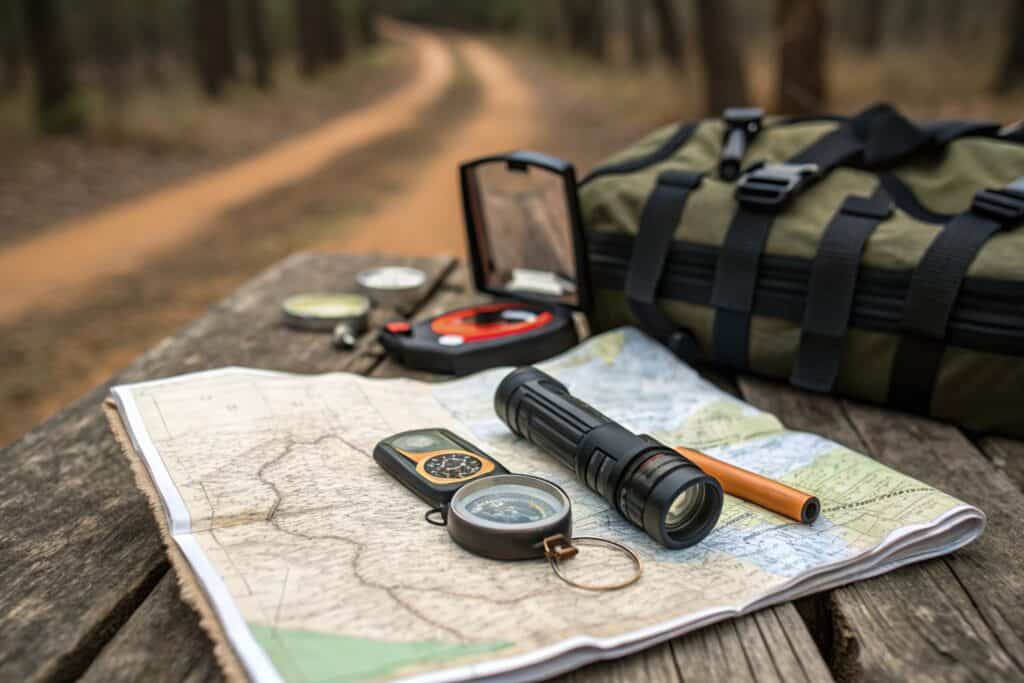
Cooking and Food Preservation Equipment
The first time I truly understood the art of wilderness cooking wasn’t in some pristine campground—it was during a brutal backcountry expedition where my carefully planned meals turned into a comedy of errors. Picture this: me, desperately trying to light a wet camp stove while horizontal rain turned my gourmet camping meal into a sad, soggy mess.
The Evolution of Wilderness Cuisine
Cooking off-grid in 2024 is light-years beyond the days of bland trail mix and canned beans. It’s a sophisticated blend of survival science, culinary creativity, and technological innovation:
Portable Cooking Systems That Actually Work
- Ultralight multi-fuel stoves
- Solar-powered cooking devices
- Compact windproof cooking systems
- Integrated water boiling and cooking technologies
- Fuel-efficient design that minimizes weight and maximizes performance
Fuel Options: More Than Just Propane
My years of wilderness cooking have taught me that fuel is the lifeline of any off-grid meal:
- Liquid Fuel Systems
- Multi-fuel capabilities
- Works in extreme temperatures
- Efficient for long-term expeditions
- Minimal weight impact
- Canister Stove Technologies
- Instant ignition systems
- Lightweight design
- Precise temperature control
- Compact storage options
- Alternative Cooking Technologies
- Solar cooking surfaces
- Biomass burning stoves
- Thermoelectric cooking devices
- Wind-resistant cooking systems
Food Preservation: Keeping Your Supplies Safe
Wilderness food management is part science, part survival art:
- Vacuum-sealed packaging techniques
- Freeze-dried meal technologies
- Portable food dehydration methods
- Temperature-controlled storage solutions
- Ultralight preservation containers
My Wilderness Meal Strategy
- 70% pre-prepared, lightweight meals
- 20% fresh, lightweight ingredients
- 10% emergency backup nutrition
- Zero unnecessary weight
Game-Changing Cooking Accessories
The tools that have transformed my wilderness cooking:
- Collapsible silicone cookware
- Multipurpose cooking utensils
- Lightweight mess kit systems
- Integrated water filtration cooking systems
- Compact cleaning and sanitization tools
Nutrition Meets Technology
2024 wilderness cooking is about more than just survival—it’s about thriving:
- Nutritionally optimized meal planning
- Calorie-dense, lightweight food options
- Personalized dietary requirement solutions
- Performance-focused nutrition strategies
Rookie Mistakes I’ve Made (So You Don’t Have To)
Wisdom from countless culinary disasters:
- Never rely on a single cooking method
- Always pack emergency food
- Learn to cook with minimal resources
- Practice your cooking techniques before the trip
- Understand your body’s nutritional needs
The Psychological Impact of Good Food
Here’s a wilderness truth: A good meal can transform a challenging expedition. I’ve seen morale rise from a simple, well-prepared hot drink in freezing conditions.
Emerging Food Technologies to Watch
The future of wilderness nutrition is incredible:
- 3D-printed nutritionally balanced meals
- Adaptive meal planning AI
- Compact nutrient extraction technologies
- Personalized wilderness nutrition systems
- Sustainable, lightweight food production methods
The Ultimate Wilderness Cooking Mindset
Cooking off-grid isn’t about recreating your home kitchen. It’s about:
- Adaptability
- Efficiency
- Nutritional intelligence
- Minimal environmental impact
- Maximum enjoyment
Pro Tip: Your most important cooking tool isn’t a stove or a utensil. It’s your creativity and ability to adapt.
Remember, in the wilderness, a good meal is more than food—it’s hope, comfort, and survival wrapped into one delicious package.
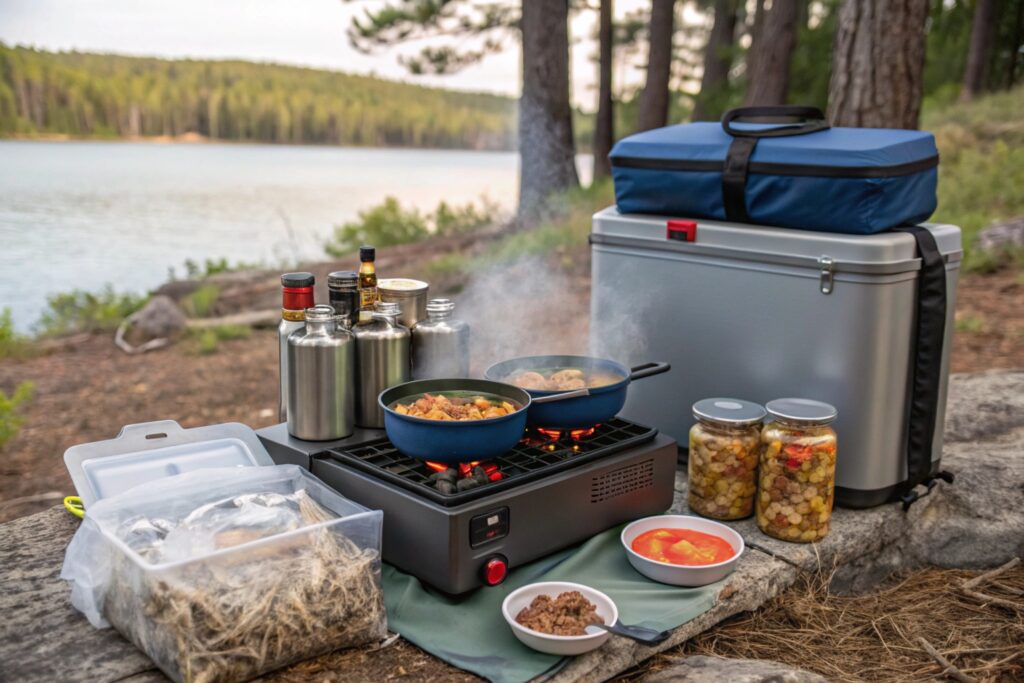
Clothing and Personal Gear for Extreme Conditions
My crash course in extreme condition clothing came during an ill-fated winter expedition in the Alaskan backcountry. There I was, shivering uncontrollably, realizing that my “waterproof” jacket was about as water-resistant as a paper towel, and my so-called “thermal” layers felt like they were made of tissue paper.
The Layering Revolution: More Than Just Putting on Clothes
Wilderness clothing in 2024 is a sophisticated science of survival, comfort, and adaptability. It’s not about how many layers you wear, but how strategically you wear them:
The Perfect Layering System
- Base layer: Moisture-wicking performance
- Insulation layer: Thermal regulation
- Outer shell: Environmental protection
- Adaptive clothing technologies
- Multi-purpose gear solutions
Materials Matter: Beyond Cotton and Wool
Cutting-edge fabric technologies have transformed wilderness clothing:
- Performance Synthetic Materials
- Rapid moisture-wicking capabilities
- Extreme temperature adaptability
- Minimal weight impact
- Durability under harsh conditions
- Advanced Insulation Technologies
- Synthetic down alternatives
- Graphene-infused thermal layers
- Phase-change temperature regulation
- Ultralight insulation systems
Personal Gear: The Survival Toolkit
My hard-learned lessons have shaped a comprehensive personal gear strategy:
- Multipurpose clothing items
- Compact emergency layers
- Adaptive temperature management
- Minimal weight, maximum functionality
- Integrated safety features
Emergency Clothing Considerations
- Compact emergency poncho
- Thermal emergency blanket
- Lightweight backup layers
- Quick-dry capabilities
- Compression storage options
Extreme Condition Survival Clothing Hacks
Wisdom from years of wilderness adventures:
- Always pack an emergency layer
- Understand fabric performance characteristics
- Learn moisture management techniques
- Prioritize versatility over fashion
- Test gear before critical expeditions
Technology Meets Personal Protection
2024 wilderness clothing is a marvel of human innovation:
- Smart fabric technologies
- Temperature-adaptive materials
- Integrated safety tracking
- UV protection systems
- Moisture management engineering
Psychological Warfare with Extreme Conditions
Here’s a wilderness truth: Your clothing is your first line of psychological defense. Feeling comfortable can mean the difference between surrender and survival.
Emerging Clothing Technologies
The future of wilderness gear is mind-blowing:
- Self-repairing fabric technologies
- AI-powered temperature regulation
- Biomimetic clothing designs
- Adaptive camouflage systems
- Integrated health monitoring fabrics
The Ultimate Survival Clothing Mindset
Wilderness clothing isn’t about looking good—it’s about:
- Adaptability
- Functionality
- Minimal weight
- Maximum protection
- Psychological confidence
Practical Packing Strategies
My refined approach to wilderness clothing:
- 40% base and insulation layers
- 30% outer shell protection
- 20% emergency backup gear
- 10% multipurpose accessories
Pro Survival Tip: Your most important piece of clothing is the one that keeps you dry, warm, and mentally confident.
Remember, in extreme conditions, your clothing is more than fabric—it’s your lifeline, your protection, and your first defense against the wilderness.
Conclusion:
From that disastrous first camping trip to becoming a seasoned off-grid adventurer, I’ve learned that wilderness survival is less about perfect gear and more about perfect preparation. The journey from novice to confident explorer isn’t measured in the equipment you buy, but in the experiences you collect and the challenges you overcome.
Off-grid camping in 2024 isn’t just about escaping technology—it’s about reconnecting with something profound and primal. It’s about proving to yourself that you’re capable of more than you ever imagined. Each piece of gear, each carefully planned strategy, is a testament to human adaptability and resilience.
Remember that nervous guy shivering in the Blue Ridge Mountains? He’s now someone who sees wilderness not as a threat, but as an invitation to adventure. And that’s the real magic of off-grid camping—it transforms you, one challenging moment at a time.
Your wilderness story is waiting to be written. The gear is just the beginning. The real adventure? That happens when you step beyond your comfort zone, embrace the unknown, and discover the incredible strength that lives within you.
Pack smart. Stay curious. And never stop exploring.
Frequently Asked Questions (FAQ)
Q1: Is off-grid camping safe for beginners?
Absolutely! While it might seem intimidating, off-grid camping is totally achievable with proper preparation. Just like my first disastrous trip, everyone starts somewhere. The key is to start small, invest in the right gear, learn essential skills, and never be afraid to ask for advice. Begin with shorter trips, research your destination thoroughly, and always tell someone your exact route. Remember, confidence comes from preparation, not bravado.
Q2: How much does it cost to get started with off-grid camping?
You don’t need to break the bank to start your wilderness adventure. While high-end gear can be tempting, smart beginners focus on essential, versatile equipment. Start with basic, reliable gear and upgrade gradually. A good strategy is to invest in critical items like a quality tent, sleeping bag, and water filtration system, and then build your kit over time. Expect to spend around $500-$1000 for a solid starter setup that will keep you safe and comfortable.
Q3: What are the biggest mistakes beginners make in off-grid camping?
Great question! Based on my own painful experiences, the top mistakes include:
- Overpacking unnecessary gear
- Underestimating weather conditions
- Failing to test equipment before the trip
- Not understanding basic wilderness survival skills
- Relying too heavily on technology
- Neglecting proper food and water preparation
The common thread? Lack of preparation. Always practice with your gear, learn basic survival skills, and approach wilderness camping with respect and humility.
Q4: How do I choose the right location for my first off-grid camping experience?
Start with beginner-friendly locations that have some infrastructure but still offer a taste of true wilderness. Look for:
- National or state parks with established backcountry camping
- Areas with reliable cell service or satellite communication
- Locations with moderate terrain and predictable weather
- Proximity to ranger stations or emergency services
Research thoroughly, check local regulations, and consider joining a guided trip or taking a wilderness skills course to build confidence.
Q5: What’s the most important piece of advice for someone wanting to start off-grid camping?
Beyond all the gear and technology, the most critical advice is to cultivate the right mindset. Wilderness camping is as much a mental challenge as a physical one. Stay curious, remain adaptable, and never stop learning. Embrace the unexpected, respect nature, and understand that every challenge is an opportunity to grow. Your greatest piece of equipment is always between your ears—your brain, your adaptability, and your spirit of adventure.
